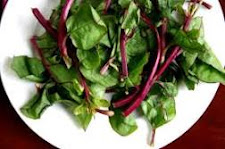Alugbati - Versatile Leafy Vegetable
Dr Abe V Rotor
There are three common types of alugbati: Basella alba with green stem and oval to almost round leaves; Basella rubra with red stems and green, oval to round leaves; and a third type, which is a hybrid of the two.
Angie Tobias, author's niece, gathers alubati tops
at the Living with Nature Center, San Vicente, Ilocos Sur.
Ginisang alugbati with pork is a popular dish among Filipinos. The easiest preparation is steamed salad with tomato, onions and a dash of salt.
At home, we cook alugbati with ground mungo, with pork or fish (roasted tilapia or hito). "Ulam na, sabaw pa." When conditions are pressing, ginisang alugbati with sardinas is a good alternative. There are other culinary preparations found in the cookbook, local and foreign.
- Healthy heart. Folate is essential to reduce the homocysteine level which is present in the blood.
- Treats depression.
- Prevent dementia.
- Treatment for cancer.
- Utilizes amino acids, iron and vitamin B12.
- Pregnancy.
- Provides energy.
A review of the taxonomy, ethnobotany, phytochemistry and pharmacology of Basella alba (Basellaceae)
S. A. Deshmukh and D. K. Gaikwad*
S. A. Deshmukh and D. K. Gaikwad*
Abstract
Basella alba L. is an important green leafy vegetables found commonly in the tropical regions of the world. The plant is used as a substitute for true spinach (i. e. Spinacea oleracea L.) and also has great ethnomedicinal importance. Different studies have proved that the plant is rich in vitamin A and vitamin C along with flavonoids, saponins, carotenoids, many amino acids and organic acids. Various in vivo and in vitro studies revealed that the plants is enriched with active substances/principles having medicinal potential. Major biological activities exhibited by Basella alba is androgenic, antidiabetic, anti-inflammatory, antimicrobial, antioxidant, antiulcer, antiviral, CNS depressant, hepatoprotective and wound healing, properties. Besides these all the plant possess a valuable ethnomedicinal importance and are used to cure digestive disorders, skin diseases, bleeding piles, pimples, urticaria, irritation, anemia, whooping cough, leprosy, aphthae, insomnia, cancer, gonorrhea, burns, headache, ulcers, diarrhea, liver disorders, bilious vomiting, sexual asthenia. ~ Acknowledgement with thanks: Internet photos, and article of SA Deshmukh and DK Gaikwad.
Basella alba L. is an important green leafy vegetables found commonly in the tropical regions of the world. The plant is used as a substitute for true spinach (i. e. Spinacea oleracea L.) and also has great ethnomedicinal importance. Different studies have proved that the plant is rich in vitamin A and vitamin C along with flavonoids, saponins, carotenoids, many amino acids and organic acids. Various in vivo and in vitro studies revealed that the plants is enriched with active substances/principles having medicinal potential. Major biological activities exhibited by Basella alba is androgenic, antidiabetic, anti-inflammatory, antimicrobial, antioxidant, antiulcer, antiviral, CNS depressant, hepatoprotective and wound healing, properties. Besides these all the plant possess a valuable ethnomedicinal importance and are used to cure digestive disorders, skin diseases, bleeding piles, pimples, urticaria, irritation, anemia, whooping cough, leprosy, aphthae, insomnia, cancer, gonorrhea, burns, headache, ulcers, diarrhea, liver disorders, bilious vomiting, sexual asthenia. ~ Acknowledgement with thanks: Internet photos, and article of SA Deshmukh and DK Gaikwad.
Author's Note: Basella alba and B. rubra are types of alugbati. A third type is a hybrid of the two. Except for their distinctive coloration, they have the same nutritional and medicinal properties, botanical characteristics and horticultural requirements. Alugbati is a perennial climbing vine propagated by cuttings and seeds. It requires a fairly fertile soil and moderate and stable soil moisture. Succulent leaves and tops are gathered directly from the backyard, trellis, plots and pots where it is raised. Alugbati is virtually pest free and does not require spraying. In case protection from insects is needed, simply crush a clove or two of garlic, crush and dilute with tap water. Apply with sprinkler or hand sprayer. ~







No comments:
Post a Comment